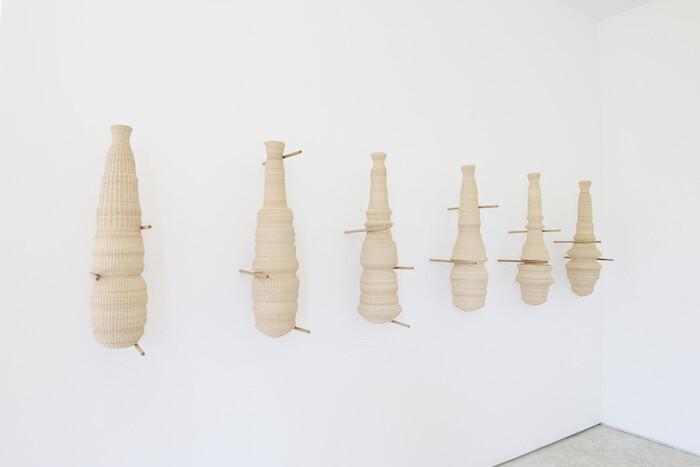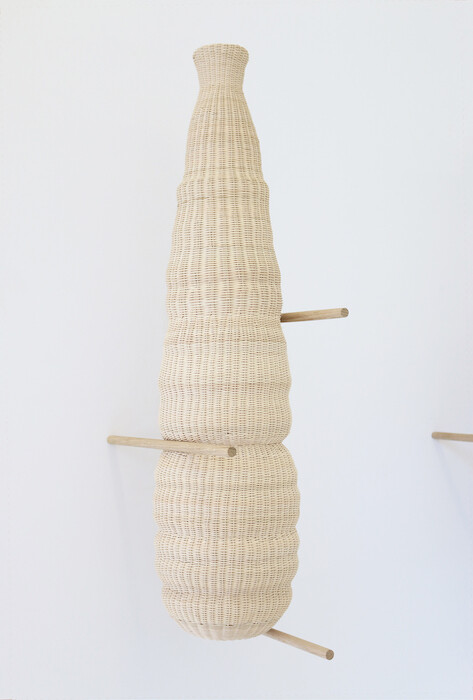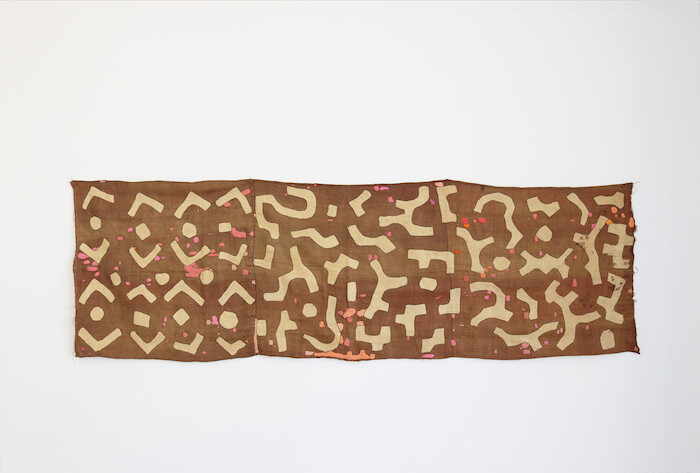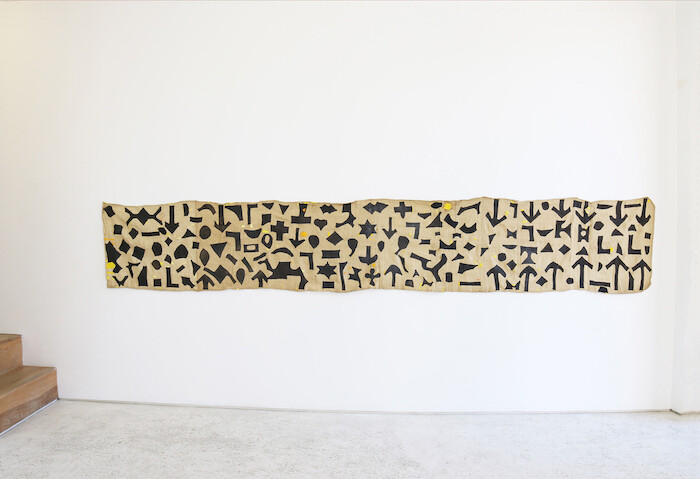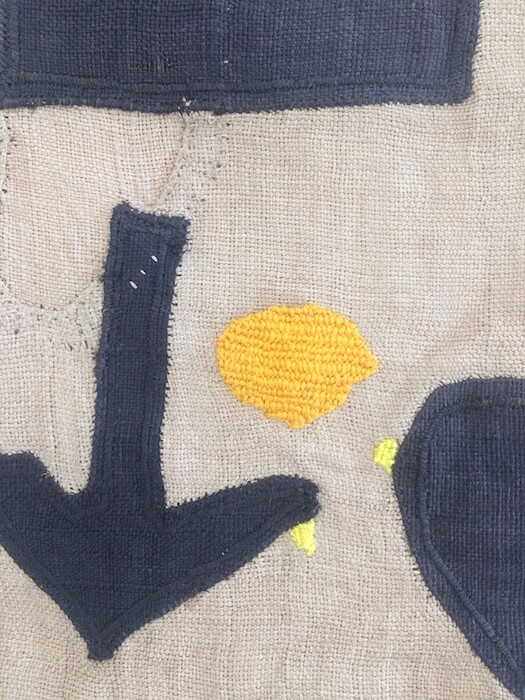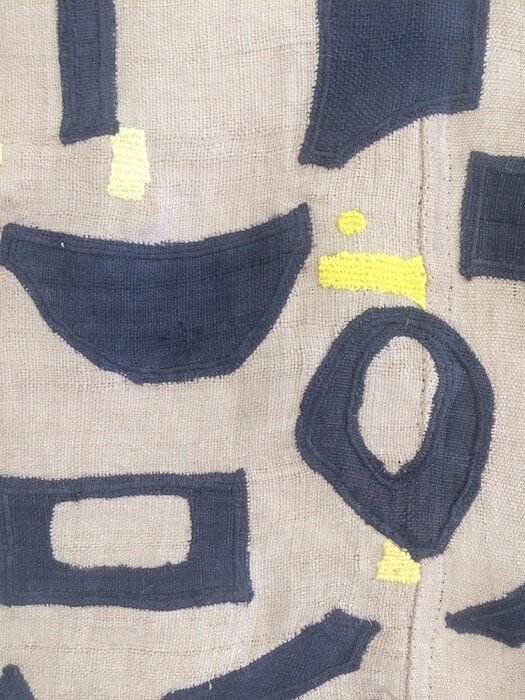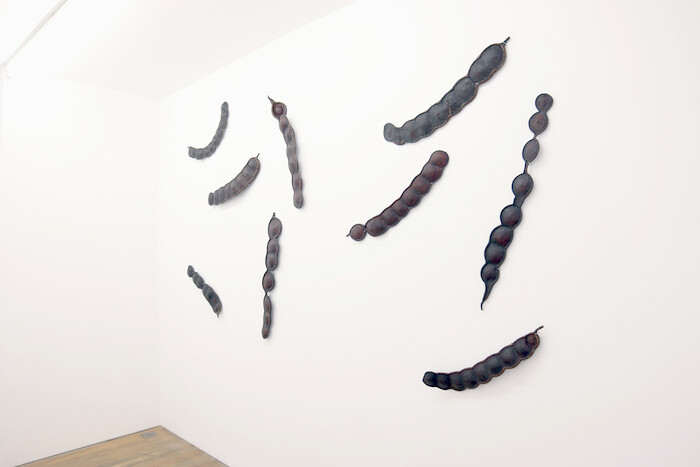One origin myth of ceramics: that far back in prehistory, basket makers packed their containers with clay to form a lining, and one day dropped one of these vessels into a fire, finding, when the ashes cooled, that the clay had hardened and remained where the woven structure was destroyed.1
Ceramics, in this narrative, supersedes basketry: and yet the practice of weaving continues, even, as the makers move from gathering to hunting to farming. Was this a practical decision, or an aesthetic preference? Some early ceramics are decorated in indented crisscross patterns, as though aspiring to resemble the earlier form.
The themes inherent in this story—about the relation between craft and art, between utility and decoration, and of the development of forms, their chronological succession—are probed via the six basketwork forms included in Dan Coopey’s “Dry.” Each one—all Untitled (all works 2017), with enigmatic, geographic subtitles: Indus, Gansu, Tuxá, etc.—is roughly cylindrical and narrows and expands along its length, as if gently squeezed, as clay is on a potter’s wheel. Made from unpainted rattan, they look somehow ritualistic, like urns, and vaguely echo the undulations of Indian stupas, but they belong to no identifiable formal tradition, as intact and sui generis as pods arrived from Mars, or ancient finds exhumed from the earth. From left to right, the structures visibly intensify in complexity, like a textbook diagram of decorative evolution.
Though referring to the ceramic tradition and its notionally intertwined history with basket weaving, Coopey undercuts the utilitarian dimension of both clay and woven vessels, as each of the six objects displayed is entirely closed, without an opening that would allow storing or carrying. The absence of openings or points of entry also makes it difficult, even impossible, to re-construct the work’s physical progression, to establish where the artist began or ended their making. In this sense, they have a strangely un-made, “pre-fab” quality: all the stranger given that each one’s entire surface, densely textured with the looping of warp and weft, is so legibly crafted, so visibly the result of hours of repetitive labor. To weave rattan means working with and against the tension inherent in the fibers themselves; each of these objects emanates a kind of sprung, tensile quality, as if the energy worked into their weave is always just on the verge of snapping open, like a seed cracking out of a pod.
And indeed, though it’s barely discernible from the exterior, each one of the baskets does indeed hold a seed of sorts—a wad of gum. Gum chewing is another practice as widespread and ancient as basket making, its origin also the stuff of speculation (what would lead a person to begin nibbling tree sap: taste? Curiosity? Or merely to pass the time?). Is the gum Coopey has implanted something organic, or artificial? To find out, you’d have to break the object open. It would be then a more useful vessel, but a broken artwork.
On the opposite wall of the gallery, a length of Kuba cloth, also untitled, is hung, sewn together from eight panels; a second, smaller example hangs separately in another room. Produced by the Kuba people of Democratic Republic of Congo, and worn in ceremonial contexts, the cloth is woven from raffia, then pounded, and sometimes decorated with geometric shapes appliquéd onto the surface of the fabric. There is no higher or lower grade of raffia, so the value of the textile is determined by process—how well woven, how thoroughly pounded—and the deployment of the vocabulary of decoration, its complexity and rhythm. Outside the circle of manufacture, it is hard for me to appreciate the craft of this cloth, and the symbolic meaning of its shapes (often kept secret even within Kuba society) is impossible for me to parse (though my eye tries to trace a narrative of sorts, as looking at the sky I instinctively trace constellations even though I don’t recognize them). I am used to trying to interpret what I see in galleries, to saying what artists are doing, or meaning to, whereas here I can only admire the craft of the cloth, or Coopey’s weaving without recourse to expression, as I might find beauty in a wall of brickwork.
In some sense, Coopey’s primary gesture with the Kuba cloth is that of a curator—to bring an object to attention, to offer it for consideration. “Curator” derives from the Latin cura, “care,” and care seems for Coopey inseparable from curiosity (the rattan objects are delicately supported by rods projecting from the wall, cradling their curves and indents). In sparse areas of the cloths where the fabric is worn, Coopey has made repairs in the form of brightly colored embroidery, which aggregates in mollusk-like bumps. Is this act one of revision, invasion, or completion? Or is the cloth always able to be modulated, worked, and worked again?
A standard basket-weaving manual won’t teach you how to close a vessel, like Coopey has, because in order to hold something, baskets remain open. The theme that emerges from this exhibition is of the implacability of endings: not only the way that the finishing of an object is rarely the end of its story, but that the moment of finishing, completion, is itself an ambiguous, shifting span. The exhibition’s third element is another installation of collectible found objects: a spread of seeds of the Entada gigas, or Coeur de Mer tree, rusty brown in hue, and swollen to fairy-tale size, pinned flush against another wall. There is perhaps here another inquiry into value—the seeds’ worth has nothing to do with artistic effort, but a grower’s slow cultivation, or the sheer luck of finding one washed up on a shore. But they also introduce another chronological horizon. If the nearby Douro river, just visible through the gallery’s window, flooded its space and wrecked the objects within it, releasing the gum from the baskets, undoing the carefully sewn repairs, how long would it take for these seeds to sprout?
In an Indian myth, it is reported that Brahma once shared sugarcane among his sons, who all ate their share, apart from the potter who was too absorbed in his work, and left the cane near his store of clay. When later Brahma asked his sons to return some cane, they all had nothing to offer—except the potter, from whose neglected share a tree had sprouted.2 Like this fable, Coopey’s exhibition pays homage to the value of patient labor, and its often unforeseeable yields.
The story is circulated in, for example, Susan Peterson & Jan Peterson, The Craft and Art of Clay: A Complete Potter’s Handbook (London: Lawrence King, 2003), 263. For a more nuanced account of the evolution, see Peter Jordan and Marek Zvelebil (eds), Ceramics Before Farming: The Dispersal of Pottery Among Prehistoric Eurasian Hunter-Gatherers (London and New York: Routledge, 2016), 53.
Baidyanath Saraswati, Pottery-making Cultures and Indian Civilization (New Delhi: Abhinav Publications, 1979), 46.
